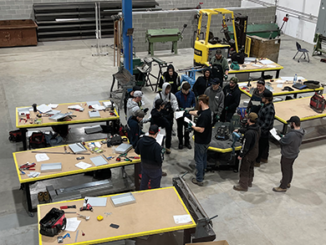
There was a time, nearly ten years ago now, when I tried to talk to people in construction about technology and innovating their practices and business models, and a certain heaviness would hang in the silence over the phone line. In person, this line of questioning would cause people to stare at me as if I were on fire. Technology? Innovation? Change? You’re barking up the wrong tree, lady.
Am I?
Here we are, just a few short years later and 78 percent of construction firms use three or more software technologies to manage their businesses, with estimating, project management, and BIM programs taking the top three popularity spots.
According to a report by Construction Executive, 77.4 percent of contractors surveyed said they receive bids electronically, and 32 percent use pencil and paper when performing a takeoff. Only 26 percent use project management or collaboration tools on the majority of their projects, while 23 percent don’t use them at all.
BIM is taking a large portion of the market, in particular for its collaborative features—according to the CE report, 65 percent of contractors surveyed use it for collaborating across the construction phase, 50 percent see its potential as a marketing tool, and 47 percent use it to collaborate with the team pre-construction.
The report lists barriers to adoption – cost of devices, resistance to chance, difficulty finding suitable programs, and cost of programs – but the natural progression of technology pricing will eventually evolve and take care of these matters, opening a whole new world of possibilities for contractors in all realms of construction.
If I could go back in time a decade and ask, I wonder what those same people would think of MacDonald-Miller’s use of virtual reality to design, view, and change projects in the pre-construction phase of a project. This is the leading edge of technology and no doubt the future of the construction process. Check out page 12 for more.
These kinds of innovations are drawing a young, smart, hard-working cohort of people to the construction trades, and thank goodness because the labor shortage isn’t going anywhere soon. The ability to draw new people to the industry is contingent on knowing what they are looking for and how that differs from what the generation before may have been looking for. Read Mark Webster’s thoughts on this on page 6.
And speaking of technology, Auburn Mechanical recently completed an incredible modular building that showcases the possibilities these structure present, especially in the realm of labor-management partnerships. Read more on page 14.
Of course, with change comes uncertainty and we all deal with that differently. Some feel thrilled by the possibilities and others feel nervous, but at the end of the day change is inevitable. It brings opportunity and chance, and welcomes a fresh slate for learning and growth. Thank goodness SMACNA-WW members have a strong, passionate association behind them for support and technical advice. Check out the fabulous association events coming up and previous highlights pages 8-11, and feel free to reach out with questions or for more information. ▪
By Jessica Kirby



